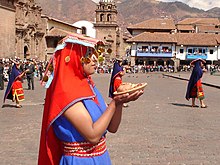Inti Raymi
This article needs additional citations for verification. (September 2023) |
| Inti Raymi | |
|---|---|
 Modern Inti Raymi at Sacsayhuamán, Peru | |
| Official name | Inti Raymi |
| Also called | Festival of the Sun, Sun Festival |
| Observed by | Indigenous communities of Peru and Ecuador |
| Type | Cultural, Religious |
| Significance |
|
| Celebrations | Reenactment of Inca rituals, feasting, music, dance |
| Date | |
| Frequency | Annual |
| Related to | Inca religion, Winter solstice |


The Inti Raymi (
During the Inca Empire, the Inti Raymi was the most important of four ceremonies celebrated in Cusco, as related by Inca Garcilaso de la Vega. The celebration took place in the Haukaypata, the Main Square in the city.
Overview
According to chronicler
In 1944, a historical reconstruction of the Inti Raymi was directed by Faustino Espinoza Navarro and indigenous actors. The first reconstruction was based largely on the chronicles of Garcilaso de la Vega and referred only to the religious ceremony. Since 1944, an annual theatrical representation of the Inti Raymi has been taking place at
Inti Raymi is still celebrated in indigenous cultures throughout the Andes. Celebrations involve music, wearing of colorful costumes (most notable the woven aya huma mask), and the sharing of food. In many parts of the Andes though, this celebration has also been connected to the western Catholic festivals of Saint John the Baptist (June 24), which falls a few days after the southern winter solstice (June 21). The celebration today begins at Qorikancha, followed by the Plaza de Armas, and other important sites of the Incan times.
Modern day re-enactment
The Inti Raymi is traditionally performed in three historical and natural settings commonly used for staging, where over 800 artists don typical gartments and engage in diverse presentations, including dances and performances. These events primarily take place at the temple of Qorikancha, the Archaeological Park of Sacsayhuaman, and the Plaza de Armas (Main Square) of Cusco.[4]
Qorikancha
The celebration begins in this temple, historically the primary site for sun worship during the Tawantinsuyu. The contemporary ceremony unfolds here before the retinue proceeds along Loreto Street or Inti K'ijllu toward the Plaza de Armas.
Plaza de Armas
Formerly referred to as Auqaypata or Warrior's Square, this location hosts rituals such as the Coca Rite and the Meeting of the Times, where the Inca meets the city's mayor to exchange the khipu representing the three powers: munay (to want), yachay (to know), and llankay (to work).
Sacsayhuamán
Situated approximately one kilometer from Qolqanpata, an Inca neighborhood, this archaeological site serves as the focal point for the central ceremony, which includes:
- Ceremonial sitting.
- Report from the 4 Suyos (regions) and Offerings: Qollasuyu, Kuntisuyu, Antisuyu and Chinchaysuyu.
- Rite of the Chicha.
- Rite of the Sacred Fire Inka.
- The Llama's sacrifice (Andean camelid) and omens.
- Rite of the Sankhu (holy bread).
- Q’ochurikuy (popular worship).
References
- ^ Teofilo Laime Ajacopa (2007). Diccionario Bilingüe: Iskay simipi yuyayk’anch: Quechua – Castellano / Castellano – Quechua (PDF). La Paz, Bolivia: futatraw.ourproject.org.
- ^ Staff Writer. "Inti Raymi, The Celebration of the Sun | Discover Peru". Retrieved 2020-07-28.
- ^ "The Wonders of Peru's Inti Raymi Festival: A Traveller's Guide". Cachi Life | Peru Tours | Peru Travel Experts. 2020-07-24. Retrieved 2020-07-28.
- ^ "Inti Raymi, 24th June". Commission for the Promotion of Peruvian Exports and Tourism - PROMPERU.
External links
 Media related to Inti Raymi at Wikimedia Commons
Media related to Inti Raymi at Wikimedia Commons- The celebration of the Sun
- Inti Raymi - Cultura Interactiva
